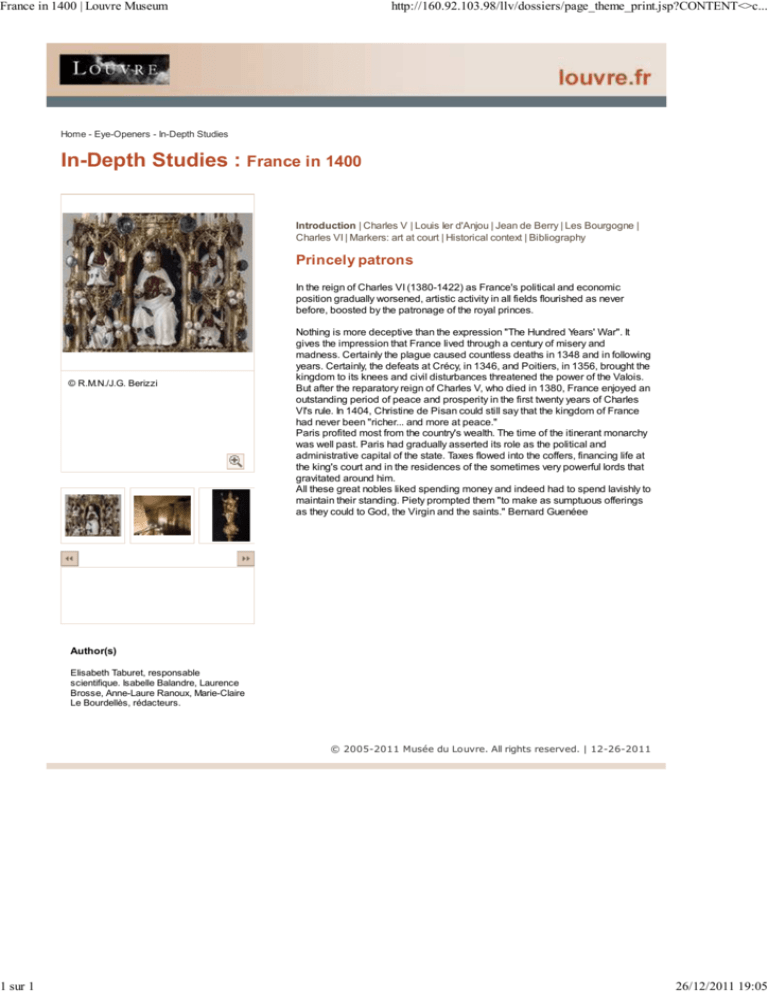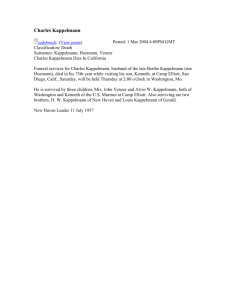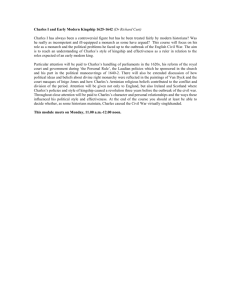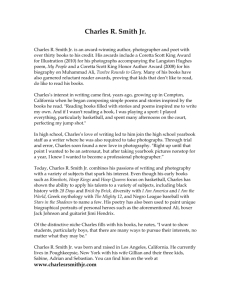
France in 1400 | Louvre Museum
1 sur 1
http://160.92.103.98/llv/dossiers/page_theme_print.jsp?CONTENT<>c...
Home - Eye-Openers - In-Depth Studies
In-Depth Studies : France in 1400
Introduction | Charles V | Louis Ier d'Anjou | Jean de Berry | Les Bourgogne |
Charles VI | Markers: art at court | Historical context | Bibliography
Princely patrons
In the reign of Charles VI (1380-1422) as France's political and economic
position gradually worsened, artistic activity in all fields flourished as never
before, boosted by the patronage of the royal princes.
© R.M.N./J.G. Berizzi
Nothing is more deceptive than the expression "The Hundred Years' War". It
gives the impression that France lived through a century of misery and
madness. Certainly the plague caused countless deaths in 1348 and in following
years. Certainly, the defeats at Crécy, in 1346, and Poitiers, in 1356, brought the
kingdom to its knees and civil disturbances threatened the power of the Valois.
But after the reparatory reign of Charles V, who died in 1380, France enjoyed an
outstanding period of peace and prosperity in the first twenty years of Charles
VI's rule. In 1404, Christine de Pisan could still say that the kingdom of France
had never been "richer... and more at peace."
Paris profited most from the country's wealth. The time of the itinerant monarchy
was well past. Paris had gradually asserted its role as the political and
administrative capital of the state. Taxes flowed into the coffers, financing life at
the king's court and in the residences of the sometimes very powerful lords that
gravitated around him.
All these great nobles liked spending money and indeed had to spend lavishly to
maintain their standing. Piety prompted them "to make as sumptuous offerings
as they could to God, the Virgin and the saints." Bernard Guenéee
Author(s)
Elisabeth Taburet, responsable
scientifique. Isabelle Balandre, Laurence
Brosse, Anne-Laure Ranoux, Marie-Claire
Le Bourdellès, rédacteurs.
© 2005-2011 Musée du Louvre. All rights reserved. | 12-26-2011
26/12/2011 19:05
Charles V | Louvre Museum
1 sur 1
http://160.92.103.98/llv/dossiers/page_theme_print.jsp?CONTENT<>c...
Home - Eye-Openers - In-Depth Studies
In-Depth Studies : France in 1400
Introduction | Charles V | Louis Ier d'Anjou | Jean de Berry | Les Bourgogne | Charles VI |
Markers: art at court | Historical context | Bibliography
Charles V
The builder king
© DR
History portrays Charles V as a good, wise king. He was an astute monarch (1338-1380)
and showed a surer taste for and keener interest in the arts than any other medieval ruler.
His support for art and culture enhanced France's influence throughout Western Europe. He
substantially enriched the royal library. A confirmed esthete, he collected jewels and
illuminated manuscripts, putting together a treasure that also served as a cash reserve.
He followed the lead of his immediate predecessors in building, altering and restoring a
large number of monuments - churches and chapels, abbeys and convents, castles and
palaces, all symbolic of royal power, such as the Louvre and other Paris residences, Saint
Pol with its menagerie, including lions, and the Château de Vincennes and its chapel,
ramparts and bridges. These major projects were often left unfinished and have now
vanished, especially his civil and military architectural achievements.
Charlemagne, an emperor and a symbol
The scepter is listed in the 1379-1380 inventory as one of the items prepared by Charles V
and entrusted to the abbot of Saint Denis on 7 May 1380 for the coronation of his son, the
future Charles VI.
The scepter may have been made for Charles V's own coronation in 1365 and redesigned
and embellished for his son.
Charles V chose the figure of Charlemagne, who was crowned emperor in 800 and
canonized in 1165, to surmount a fleur-de-lis at the top of the scepter. Charlemagne was
already worshipped as a saint and the first Valois kings sought legitimacy by venerating
him as a political figure. Charles V and his son both bore the first name of their mythical
ancestor, Carolus, who had given his name to the Carolingian dynasty to which these kings
wished to attach their lineage. The recent accession of the Valois to the crown (Philip VI in
1328) began a new era of art in the service of power.
Files
Timeline
Maps
Game
Portraiture
In Western Europe, the taste for portraiture grew steadily stronger throughout the 14th
century. Although in the previous period more importance had been put on the
representation of power than on physical likeness, efforts were now made to capture
personal features in a recognizable way. Charles V understood the value of communication
and had his portrait circulated through various media - manuscripts and sculptures.
Christine de Pisan, the royal biographer, described him as having "a longish face", a "high,
broad forehead", "quite a haughty nose" and "not too small a mouth".
After his death, his three brothers Jean, duke of Berry, Louis of Anjou, and Philip the Bold,
governed the kingdom until the dauphin came of age in 1380 and was crowned Charles VI,
King of France (1380-1422).
© 2005-2011 Musée du Louvre. All rights reserved. | 12-26-2011
26/12/2011 19:05
Louis I of Anjou | Louvre Museum
1 sur 1
http://160.92.103.98/llv/dossiers/page_theme_print.jsp?CONTENT<>c...
Home - Eye-Openers - In-Depth Studies
In-Depth Studies : France in 1400
Introduction | Charles V | Louis Ier d'Anjou | Jean de Berry | Les Bourgogne | Charles VI |
Markers: art at court | Historical context | Bibliography
Louis I of Anjou
Louis I, duke of Anjou
© CNMHS/SPADEM / Caroline Rose
Charles V chose Louis, the second son of John the Good, to govern the kingdom. When
Charles VI was crowned, Louis laid hands on the royal treasure and directed the regency
council. In 1380, Jeanne d'Anjou, who had no heir, bequeathed him the kingdom of Naples.
He then abandoned France and turned his attention to southern Italy. He died in Bari in
1384 after have spent large amounts of French money without ever governing the kingdom
that Charles V had entrusted to him.
Like Charles V and his other brothers, Louis of Anjou was a great patron of the arts. Under
their influence art developed a "private" dimension, serving secular purposes and
increasingly personal devotions. Princes and nobles followed the royal example, soon
taking the initiative in creativity, and their underlying political motives led to stimulating
rivalry in the artistic sphere. Anjou became a duchy, established an accounting office and a
school of music and singing, and consolidated its university. Louis of Anjou was
instrumental in the development of storied tapestry during the reign of Charles V by
commissioning the spectacular hangings known as the Apocalypse Tapestry of Angers.
Louis' taste for jewelry and gold work
Of all the sons of John the Good, Louis of Anjou was most passionately fond of gold work
and jewelry: hard stone vases, gold and silver tableware and jewelry, enameled gold work.
For the chapel of his castle in Saumur, which was completed in 1373, he had a window with
three mullions brought from Paris. Patrons who cared about quality did not hesitate to call
in the leading artists of the time; Paris was a major center for glazing long before 1380 and
remained so throughout the reign of Charles VI, who granted glaziers tax exemptions.
Although Louis has left little trace of a love of books, he collected an astounding amount of
jewelry and gold work which is listed in several inventories. The inventory drawn up in
1379-80 gives an idea of the sumptuous pieces he commissioned. Unfortunately, he had
his treasures melted down to finance his Italian expeditions, and nothing has survived but
the two halves of a mirror case.
Files
Timeline
Maps
Game
© 2005-2011 Musée du Louvre. All rights reserved. | 12-26-2011
26/12/2011 19:05
Jean de France, duke of Berry | Louvre Museum
1 sur 2
http://160.92.103.98/llv/dossiers/page_theme_print.jsp?CONTENT<>c...
Home - Eye-Openers - In-Depth Studies
In-Depth Studies : France in 1400
Introduction | Charles V | Louis Ier d'Anjou | Jean de Berry | Les Bourgogne | Charles VI |
Markers: art at court | Historical context | Bibliography
Jean de France, duke of Berry
An art lover and talent scout
© Photo RMN / Les frères Chuzeville
Of all the sons of John the Good, Louis of Anjou was most passionately fond of gold work
and jewelry: hard stone vases, gold and silver tableware and jewelry, enameled gold work.
For the chapel of his castle in Saumur, which was completed in 1373, he had a window with
three mullions brought from Paris. Patrons who cared about quality did not hesitate to call
in the leading artists of the time; Paris was a major center for glazing long before 1380 and
remained so throughout the reign of Charles VI, who granted glaziers tax exemptions.
Although Louis has left little trace of a love of books, he collected an astounding amount of
jewelry and gold work which is listed in several inventories. The inventory drawn up in
1379-80 gives an idea of the sumptuous pieces he commissioned. Unfortunately, he had
his treasures melted down to finance his Italian expeditions, and nothing has survived but
the two halves of a mirror case.
A collector of cameos and intaglio gems
Files
Timeline
Maps
Game
The duke of Berry shared Charles V's love of cameos and intaglio gems. Although his
collection was smaller than his brother's, he nonetheless owned about thirty cameos, loose
or set into rings, and many others attached to reliquaries.
In 1402, in exchange for relics of St Denis, Jean de France had given the abbey a large
silver reliquary (weighing about 60 kg) containing fragments of the saint's arm bones and
skull; the saint is shown half-length, wearing a miter and a chasuble displaying the arms of
Berry; the entire piece stood on a base with the arms of Berry and decorated with about
sixty cameos and intaglio gems, which were removed during the Revolution.
Like most of his contemporaries, the duke commissioned several "cameo crosses", but
the only surviving example of such crosses is that of the emperor Charles IV, in Prague. The
cross the duke commissioned from the goldsmith Hermann Ruissel for the Sainte Chapelle
in Bourges was finished after his death; it was made of silver gilt, studded with pearls,
precious stones and cameos which were removed during the Revolution, while the cross
itself was melted down.
Some of these cameos may have been part of Charles V's collection before belonging to
his brother. Several are similar to those described in the royal inventory.
A book lover
The ducal library was similar to the library built up by Charles V although the content was
less intellectual: the duke of Berry had a large number of translations of ancient authors
(very few texts in the original language) and richly illuminated manuscripts. In the 1370s, his
taste was very close to that of his elder brother. When Charles V died, the books he chose
from the king's library showed a liking for precious liturgical books especially those
executed by Jean Pucelle. Several years later, he had become the greatest talent scout
and an innovative connoisseur, influencing the work of the artists of his time.
Like the sculptor André Beauneveu, Jacquemart de Hesdin came from Valenciennes; he
spent his whole career in the service of the duke of Berry. "The Way of the Cross", the only
surviving page from the manuscript of the Grandes heures du duc de Berry, is a full page
painting taken from the book and pasted on canvas. Its size and complex spatial
representation make it a real painting.
Through his discerning taste and insatiable search for the best contemporary artists, from
Jacquemart de Hesdin to the Limburg brothers, the duke of Berry made a decisive
contribution to the renewal of art in his time and to various religious establishments,
particularly Notre Dame de Paris.
A builder
26/12/2011 19:06
Jean de France, duke of Berry | Louvre Museum
2 sur 2
http://160.92.103.98/llv/dossiers/page_theme_print.jsp?CONTENT<>c...
During the reign of Charles VI, the king and royal princes adopted a new style of
architecture. Although Charles V had called on Raymond Du Temple, under whose
influence the Rayonnant Gothic style prevailed for many years, it was only after his death,
when other European courts had long since adopted the Flamboyant style that this type of
architecture made a timid appearance in France, first of all in the Sainte Chapelle in
Vincennes.
However, on the death of Charles V, Jean de France built a Sainte Chapelle in Riom and
transformed the palace in Poitiers in a resolutely innovative style.
The duke of Berry was a builder throughout his life, erecting some remarkable buildings of
which few have survived intact to the present day. He built the Sainte Chapelle at Bourges.
As he traveled widely, he liked to feel "at home" on one of his properties wherever he went,
so he built residences at Nonette in Auvergne, Luisignan in Poitou, and Genouilly in Berry,
but also at Giens, Montargis, Etampes and Dourdan. In Paris, he owned the Hôtel de Nesle
and the Château de Bicêtre and he also had the marvelous château de Mehun sur Yèvre,
15 km from Bourges.
© 2005-2011 Musée du Louvre. All rights reserved. | 12-26-2011
26/12/2011 19:06
Philip the Bold and John the Fearless | Louvre Museum
1 sur 2
http://160.92.103.98/llv/dossiers/page_theme_print.jsp?CONTENT<>c...
Home - Eye-Openers - In-Depth Studies
In-Depth Studies : France in 1400
Introduction | Charles V | Louis Ier d'Anjou | Jean de Berry | Les Bourgogne | Charles VI |
Markers: art at court | Historical context | Bibliography
Philip the Bold and John the Fearless
Philip the Bold and the Chartreuse de Champmol
© DR
A great patron, Philip the Bold (1342-1404) consolidated the power of his duchy and turned
Burgundy into an important center for the arts. Through his marriage to Margaret of
Flanders, he inherited Flanders in 1384. Architects, sculptors, painters, carpenters,
founders, glaziers, and tile makers from Burgundy, France, Flanders and even Spain came
to work on his many construction sites in Burgundy, Flanders and in the ducal residences in
Paris.
His major commission was the building of the Chartreuse de Champmol, near Dijon, the
burial place of the dukes of Burgundy. It became one of Europe's most important centers of
the arts, directed at first by Drouet de Dammartin, the assistant of Raymond Du Temple, the
architect of the Louvre, and the brother of Guy de Dammertin, the architect of the duke of
Berry. The sculpture workshop attracted artists from northern France and the Netherlands in
the particular: after Jean de Marville from 1372 to 1389, Claus Sluter imposed his powerful
personality on the entire project. He sculpted the statues on the gate and the Well of
Moses. Other artists from the Netherlands worked alongside him, especially his nephew
Claus de Werve, who later took charge of the workshop from 1406 to 1439. For over twenty
years, the duke devoted large sums to the construction and decoration of the charterhouse
and to acquiring the land that ensured the monastery's prosperity until the Revolution.
Illuminators and painters at the Burgundy court
Files
Timeline
Maps
Game
In Paris, exchanges between the many centers of the arts in Europe were considerably
facilitated by the movement of artists from court to court, and by international marriages,
such as that of Charles V to a Bavarian princess or of Louis of Orleans to a princess from
Milan. Burgundy had relations in trade and the arts with the nearby Netherlands, and the
transfer of the pope's residence to Avignon led to renewed contacts with Italy.
The dukes of Burgundy occasionally called on Parisian painters and most of the
manuscripts bought by Philip the Bold were executed in Paris. The duke's court painters,
who worked on the charterhouse, came from northern France and the Netherlands:
Melchior Broederlam worked in Flanders on the altar pieces for the monastery. Jean de
Beaumetz, Jean Malouel and Henri Bellechose worked on site painting decorations, altar
pieces and polychrome statues.
Jean Malouel, previously in the service of Isabella of Bavaria, queen of Charles VI, became
court painter to the duke in 1397. He belonged to an important family of Flemish artists that
included his nephews (the three Limburg brothers), André Beauneveu, and Jean de
Beaumetz, all of whom developed their styles in contact with Paris. Around 1400, he
painted the large round Pietà which combines a Flemish concern for realism in the
modeling of the body with the elegant line and preciosity of colors characteristic of Parisian
illumination work.
John the Fearless
John the Fearless became duke of Burgundy on the death of his father, Philip the Bold. He
wished to enlarge and consolidate the duchy of Burgundy, while occupying the leading
position in the government of the kingdom of France. The greater part of his resources
came from the royal treasury. In his quest for power during Charles VI's illness, he
encountered the opposition of his cousin, Louis of Orléans, who was assassinated on
John's orders in 1407. The murder precipitated the struggle between the Armagnacs and
the Burgundians.
In 1409, as a symbol of his taking control of the kingdom of France, John the Fearless had
Robert de Helbuterne build for him in Paris a mansion decorated with his arms and those
of his wife, Margaret of Bavaria. Backing on to the ramparts built by Philip II Augustus, its
twenty-seven-meter-high tower still dominates Paris. It used to serve the various floors of
the building by means of a spiral staircase. The vault of this large staircase (modeled on
Charles V's staircase at the Louvre) is decorated with an unusual, specifically Burgundian
design, a polychrome stone sculpture whose plant motifs - oak, hawthorn, and hops -
26/12/2011 19:06
Philip the Bold and John the Fearless | Louvre Museum
2 sur 2
http://160.92.103.98/llv/dossiers/page_theme_print.jsp?CONTENT<>c...
symbolize the father Philip the Bold, the mother Margaret of Flanders, and the son, John the
Fearless.
© 2005-2011 Musée du Louvre. All rights reserved. | 12-26-2011
26/12/2011 19:06
Charles VI and Isabella of Bavaria | Louvre Museum
1 sur 1
http://160.92.103.98/llv/dossiers/page_theme_print.jsp?CONTENT<>c...
Home - Eye-Openers - In-Depth Studies
In-Depth Studies : France in 1400
Introduction | Charles V | Louis Ier d'Anjou | Jean de Berry | Les Bourgogne | Charles VI |
Markers: art at court | Historical context | Bibliography
Charles VI and Isabella of Bavaria
Charles V's heir
Patrick Müller © CMN, Paris
In 1380, Charles VI inherited the collections his father had built up - nearly 4,000 items along with many gifts from the queen, the princes and cities of the kingdom. Unfortunately,
this treasure went on pledges or was melted down. Although his collection was dispersed
as his reign wore on, Charles VI nonetheless played a major role in the development of art
in his time. As expected of a good king, he gave sumptuous gifts to his family and friends.
He continued the building projects begun by his father, especially at Vincennes, and
endowed several churches with crosses and chalices..
The Louvre in the time of Charles VI
The Louvre was pushed into the background during the reign of Charles VI. Although
Isabella of Bavaria gave birth to a daughter in the Louvre in 1389 - Isabella, the future wife
of Richard - and although a few council meetings and the reception of two emperors from
Constantinople were held there, the court moved to the Hôtel Saint Pol and the Hôtel des
Tournelles.
Nothing remains of the Louvre from Charles VI's time, except the fragments of his helmet
found at the bottom of a well in the keep of Philip II Augustus, during the excavations in
1984. The helmet had been smashed to pieces (155 in all) and thrown into the well. The
helmet was attributed to Charles VI on the grounds that it was in the Louvre in 1411 and
was described in the accounts of the Royal Stable. There is no other known example.
The role of Isabella of Bavaria
Files
Timeline
Maps
Game
The daughter of Stephen III, duke of Bavaria, and Thaddaea Visconti. Isabella was fifteen
when she married the king; she did not speak French and was unaccustomed to court
etiquette. She bore him twelve children and took the brunt of his outbursts of rage. At the
same time, she played a major role as an art patron, commissioning paintings, gold and
silver tableware, jewelry and sumptuous garments in the fashion of the day from a large
number of artists. Isabella was also very fond of books, as is shown by the money she
lavished on copying, illuminations, binding, clasps and bookmarks.
She gave her husband a magnificent "Image of Notre Dame" known as the "Golldenes
Rössl"; its refinement and technical perfection testify to the prowess of the goldsmiths
working in Paris for princely patrons in the late Middle Ages.
© 2005-2011 Musée du Louvre. All rights reserved. | 12-26-2011
26/12/2011 19:06
Art at Court and Iconographic Themes | Louvre Museum
1 sur 2
http://160.92.103.98/llv/dossiers/page_theme_print.jsp?CONTENT<>c...
Home - Eye-Openers - In-Depth Studies
In-Depth Studies : France in 1400
Introduction | Charles V | Louis Ier d'Anjou | Jean de Berry | Les Bourgogne | Charles VI |
Markers: art at court | Historical context | Bibliography
Art at Court and Iconographic Themes
Iconographic Themes
The gift of the heart
1400-10
© R.M.N.
Files
Timeline
Maps
Game
The theme of the "Nine Worthies" was very popular in the arts. Jacques de Longuyon's
poem "Les Voeux du paon", written about 1312, brought together nine heroes from three
ages who incarnated the chivalrous values (wisdom, prudence, bravery, piety, virtue and
love). From Biblical history, Joshua, Moses' successor who had led the people of Israel to
the Promised Land; Judas Maccabeus, leader of the Hebrews; and Christ's ancestor,
David, king of Israel and a psalm-writer. From Ancient history: Hector, who had defended
Troy during the Trojan War; Alexander the Great; and Julius Caesar, the founder of the
Roman Empire. From medieval history: Charlemagne, emperor of Western Europe,
Godefroy de Bouillon, the hero of the First Crusade in 1099; King Arthur of the Quest for the
Holy Grail with the knights of the Round Table. Du Guesclin, who had distinguished himself
under Charles V against the English, was later added to the list. Five of these heroes still
figure as the kings and a jack on French court cards.
Taking its cue from literature, art explored the conventions of courtly love with garden walks
and love scenes. Under the influence of the Italian painters, nature and gardens became
part of the décor.
Epidemics of plague ravaged the country in the 14th century and death became a familiar
sight. After 1396, the dissection of corpses was authorized. Dead people were then shown
in a highly realistic manner: naked, gaunt (as recumbent effigies) or even as worm-eaten
corpses.
Emblems and precious objects
Devices and emblems were an integral part of the decoration. The king and the princes
chose their personal marks: an emblem and a color together with a brief motto. Charles VI
had several emblems: a winged stag (on his helmet), a peacock, a broom pod and a lion,
as well as the color green and "en bien" as his motto. Isabella chose the flower of scarlet
pimpernel, Louis of Orleans, a porcupine, a wolf and nettle leaves. The duke of Berry took a
black bear and a swan. John the Fearless used a plane (on his ring) and a hop leaf (on the
vault of the staircase in the tower).
The costumes embroidered with gold or studded with jewels that we see in miniatures are
remarkably sumptuous: silk, satin or velvet, fur-lined coats, lavishly draped hoods for the
men and horned or padded headdresses topped with veils for the women. The colors are
bright and refined: pink, red, green, blue.
Highly sophisticated techniques were used to make jewelry: enameled gold sculptures of
plants and animals as well as cameo portraits set in rings. The king and the royal princes
owned considerable quantities of gold and silver objects which they brought out of their
treasuries for grand receptions: tableware, reliquaries, and liturgical objects commissioned
from the greatest Parisian goldsmiths.
Literature and poetry
Charles VI inherited 900 manuscripts from his father. Translations from Latin, both ancient
(Ovid) and medieval, had flowered under Charles V; translation of the works of Italian
authors (Petrarch, Boccaccio) followed.
In the late 14th century, prose dominated narrative writing and poetry was separated from
music. Guillaume de Machaut was the last composer-poet; Froissart and Deschamps were
poets only. Polyphonic music required compositional skills but paid little heed to the text
which soon became difficult for the listeners to understand.
Literature was an integral part of life at court, especially the art of lyric poetry which was
practiced by princes and art patrons. The poet-prince exchanged poems with his poets,
keeping up a dialogue in which differences in social rank seemed to be abolished.
Froissart advised the duke of Brabant in amorous matters, Christine de Pisan wrote love
poems for her patrons. A discussion about the theme of the ballads (advice in love) gave
rise to a poetry contest inaugurated in 1389 in the presence of Charles VI.
In these troubled times, authors readily aired their political views in their writings. Topical
26/12/2011 19:06
Art at Court and Iconographic Themes | Louvre Museum
2 sur 2
http://160.92.103.98/llv/dossiers/page_theme_print.jsp?CONTENT<>c...
matters were discussed: instructions for good government and legal and moral treatises
flourished. For the first time, the French court became the literary centre of the kingdom.
© 2005-2011 Musée du Louvre. All rights reserved. | 12-26-2011
26/12/2011 19:06
The Historical and Political Context | Louvre Museum
1 sur 2
http://160.92.103.98/llv/dossiers/page_theme_print.jsp?CONTENT<>c...
Home - Eye-Openers - In-Depth Studies
In-Depth Studies : France in 1400
Introduction | Charles V | Louis Ier d'Anjou | Jean de Berry | Les Bourgogne | Charles VI |
Markers: art at court | Historical context | Bibliography
The Historical and Political Context
The Hundred Years' War
Plaque de fourreau
1402 (?)
© R.M.N./J.G. Berizzi
Files
Timeline
Maps
Game
In 1322, Edward III of England was Philip the Fair's only grandson by direct descent. But
Philip the Fair's brother Philippe de Valois was crowned king of France. In 1337, he seized
the duchy of Aquitaine which belonged to England. Edward III then proclaimed himself king
of France and the war began. By the treaty of Brétigny (1360), John the Good, who was
captured at Poitiers, gave England Aquitaine, Calais and a few other towns; in return,
England waived her claim to the crown of France. In 1369 Charles V recovered his lands
with troops led by the Constable of France, Du Guesclin.
Richard II became king of England in 1377, and Charles VI acceded to the French throne in
1380. The two kings applied a pacifist policy, favored by economic stability. In 1396,
Richard II married Charles VI's daughter, Isabelle.
1399 was a time of upheaval in both countries: in England the throne was usurped by the
king's cousin, Henry of Lancaster; in France, conflict between the king's brother, Louis of
Orleans, and his uncle, the duke of Burgundy, led to civil war, in which the Armagnacs and
the Burgundians alternately called on the English. In 1412, King Charles VI, who suffered
from bouts of insanity, tried to stop the war. The English landed in France and there ensued
a period of negotiations which came to nothing. After the French defeat at Agincourt in
1415, the English, with the support of the Burgundians, occupied the kingdom of France.
Civil War: Armagnacs against Burgundians
The internal conflict between the king's brother, Louis of Orleans, and his uncle, the duke of
Burgundy, led to a civil war between the two parties: the Armagnacs and the Burgundians
who, turn about, called on England for help. In 1412, King Charles VI, who suffered from
bouts of insanity with brief lucid spells, tried in vain to stop the war. The English marched
into France and played on the divisions between the parties: the Burgundian party, led by
John the Fearless and allied to the queen, in Paris; and the Armagnac party grouped
around the dauphin, the future Charles VII, in Bourges. The assassination of John the
Fearless, duke of Burgundy, by the dauphin's men on 10 September 1419 hastened the
alliance of Henry V, king of England, and the new duke of Burgundy, Philip the Good. On 29
May 1420, the treaty of Troyes put a seal on the marriage of Catherine of France and Henry
V, who was designated as the future heir of Charles VI, under the regency of the duke of
Bedford, while the "so-called dauphin", the legitimate son of Charles VI, was stripped of his
rights to the crown. In August 1422, on the death of Charles VI, the dauphin Charles
claimed the title of king of France: Armagnac France then rose up against AngloBurgundian France.
Popular uprisings
In 1380, the government of the uncles of Charles VI tried to reintroduce the direct and
indirect taxes abolished by Charles V. Popular riots led to a massacre of the rich. Towns
rose up one after another: Rouen, Paris, Ghent, Lyons then Amiens. In Paris, the "Maillotin
uprising" took its name from the hundreds of lead mauls (maillotins) found in the Town Hall.
The royal government decreed an amnesty and convened the Estates General of Northern
France which finally granted the raising of the tax. The most roughly punished were the
people of Rouen, who lost their trade privileges, and the Flemish (the "crusade" of
Flanders); the leaders of the Maillotin movement in Paris were hung.
In 1413, the Estates General of Northern France met in a Paris controlled by the duke of
Burgundy. John the Fearless responded to the negotiations and demands for reform by
egging on rough elements among the rich butchers and humble skinners, led by Simon
Caboche. Nobles, clerks and officers were threatened especially those close to the king.
Violent rioting broke out leaving many dead. John the Fearless lost control of the movement
he had set in motion. The reforms went on all the same and a decree listing 259 clauses, a
veritable administrative code, was published on 27 May. Order was restored, the burghers
having tired of the disorder and the people having grown weary of the butchers' tyranny.
26/12/2011 19:07
The Historical and Political Context | Louvre Museum
2 sur 2
http://160.92.103.98/llv/dossiers/page_theme_print.jsp?CONTENT<>c...
The Great Western Schism
The crisis that split Christendom began in 1309: pope Clement V fled to Avignon to escape
civic disturbances in Rome. In 1367, Urban V decided to return to Rome, but his
administration stayed in France. His successor, Gregory XI, put an end to the papacy in
Avignon.
The death of Gregory XI, in 1378, marked the beginning of the "Great Schism" in Western
Europe. The council of cardinals elected an Italian pope, Urban VI. Charles V, king of
France, protested and a group of French cardinals elected an antipope, Clement VII.
Europe split into "urbanists" and "clementists". The papacy was faced with heresies and
calls for reform (John Wyclif and Jan Hus).
The German emperor Sigismund imposed a meeting of a council on the shores of Lake
Constance in 1415; the cardinals elected Oddone Colonna. Under the name of Martin V,
the new pope took up residence in Rome in 1417. On the pope's initiative, a new council
met in Basle in 1431 with a view to reforming the Church or even reuniting the Eastern and
Western churches. Martin V's successor Eugenius IV, who cared little for reform, dissolved
the council. The conciliar Fathers objected and retired to Constance, where they elected
Duke Amadeus VIII of Savoy to the papacy. The last antipope took the name of Felix V.
Christendom saw the specter of schism loom up again, but it did not last. Half a century of
struggle between popes and antipopes in Rome and Avignon thus came to an end.
© 2005-2011 Musée du Louvre. All rights reserved. | 12-26-2011
26/12/2011 19:07
Paris 1400 | Louvre Museum
1 sur 2
http://160.92.103.98/llv/dossiers/detail_bibliographie_print.jsp?CON...
Home - Eye-Openers - In-Depth Studies
In-Depth Studies : France in 1400
© DR
Files
Timeline
Maps
Game
Introduction | Charles V | Louis Ier d'Anjou | Jean de Berry | Les Bourgogne | Charles VI | Markers: art at court | Historical context |
Bibliography
Paris 1400
A list of books used to prepare this dossier, with our comments.
Paris 1400, les arts sous Charles VI Catalogue de l'exposition, Musée du Louvre, RMN, Paris, 2004.
For adults.
Les Fastes du Gothique : le siècle de Charles V, RMN, Paris 1981.
For adults.
Les Princes des fleurs de lys : la France et les arts autour de 1400, RMN, 2004.
The flowering of the arts around 1400, for adults.
L'art à la cour de Bourgogne, le mécénat de Philippe le Hardi et Jean sans Peur et l'art en Bourgogne, Dijon, 2004.
Le Moyen-Age, Louvre, Paris-musées, Chronologies du Louvre, 2004.
A chronological leaflet which situates 120 works from the collections of Western, Byzantine and Islamic art.
For adults.
Vivre au Moyen Age : la France en 1400, Louvre, Hachette jeunesse, 2004.
Everyday life in the late Middle Ages.
For children.
L'Art de cour sous Charles VI, Guide de l'exposition Paris 1400, Faton, Le Petit Léonard n 80, avril, 2004.
For children.
L'Art de cour au Moyen Age
Faton, TDC n 872, mars 2004.
The magazine for primary and secondary school teachers "Textes et documents pour la classe" has published a special issue on the
late Middle Ages, related to exhibitions at the Cité de la Musique, the Louvre and the Musée de Cluny.
For children.
AUTRAND Fr., Charles VI, Fayard, Paris 1986.
26/12/2011 19:07
Paris 1400 | Louvre Museum
2 sur 2
http://160.92.103.98/llv/dossiers/detail_bibliographie_print.jsp?CON...
A comprehensive biography of King Charles VI.
For adults.
CASSAGNES-BROUQUET S., Culture, artistes et société dans la France médiévale, Ophrys, 1998.
A review of the places where artists were trained and the way art and culture was handed on.
For adults.
CONTAMINE Ph., La Guerre de Cent Ans, PUF, Que sais-je, 1309, 8e éd, Paris, 2002.
The causes, phases and consequences of the war between France and England.
For adults.
FAVIER J., Paris, deux mille ans d'histoire, Paris 1997.
For adults.
RECHT R. et CHATELET A., Le monde gothique : automne et renouveau, 1380-1500, Paris 1988.
For adults
SCHNERB B., Armagnacs et Bourguignons,
Perrin, 2001.
The causes and course of civil conflict during the reign of Charles VI.
For adults.
VILLELA-PETIT I., Le Gothique international : les arts en France en 1400, Louvre, Hazan, L'Atelier du monde, 2004.
The flowering of the style characteristic of the late Middle Ages.
For adults.
On Internet
1. Charles V and Charles VI
http://www.bnf.fr/enluminures/themes/t_1/st_1_01/s101_002.htm
The coronation of Charles V and Charles VI in illuminated manuscripts in the BNF.
http://gallica.bnf.fr/Anthologie/notices/00213.htm
The manuscript of the Chronicles of Jean Froissart and the events of 1389-1400. (link to come)
http://www.thebritishmuseum.ac.uk/compass/ixbin/goto?id=OBJ595
The Cup of St Agnes, a gift of John, duke of Berry to Charles VI, on the British Museum site.
2. Louis I, duke of Anjou
http://www.metmuseum.org/toah/hd/valo_1/hd_valo_1.htm
The Apocalypse Tapestry among other works in the court of the first Valois kings, in the chronology of the Metmuseum.
3. John, duke of Berry
http://www.bnf.fr/enluminures/texte/manuscrit/man9.htm (préciser le lien)
Illuminated manuscripts: Les Petites Heures de Jean de Berry on the site of the BNF.
http://www.metmuseum.org/collections/view1.asp?dep=7&mark=4&full=0&item=47%2E101%2E4#a
Tapestry: the Nine Worthies at the Cloister Museum, New York.
http://www.cg18.fr/cg/histoire/page.html#haut%20de%20page
Architecture: the Palace and Sainte Chapelle of Bourges on the site of the Conseil général du Cher.
4. Philip the Bold and John the Fearless, dukes of Burgundy
http://dijoon.free.fr/retable.htm
The Well of Moses, the Altarpiece of the Crucifixion and the tomb of Philip the Bold, on the site of the Musée des Beaux Arts de Dijon.
http://dijoon.free.fr/tombeausanpeur.htm
The tomb of John the Fearless, on the site of the Musée des Beaux Arts de Dijon.
http://perso.wanadoo.fr/tourjeansanspeur/
The tower of John the Fearless, sole remainder of secular fortified architecture in medieval Paris.
http://www.culture.gouv.fr/culture/medieval/francais/vqcost1.htm
Medieval clothing, accessories and headdress, on the site of the Ministry of Culture.
Charles VI
Bibliography
© 2005-2011 Musée du Louvre. All rights reserved. | 12-26-2011
26/12/2011 19:07








